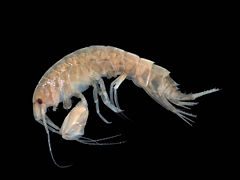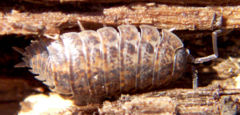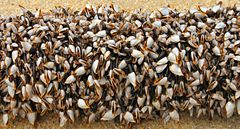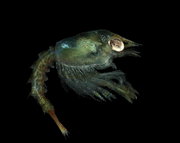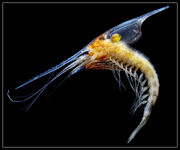Crustacean
2008/9 Schools Wikipedia Selection. Related subjects: Organisms
|
||||||||||||
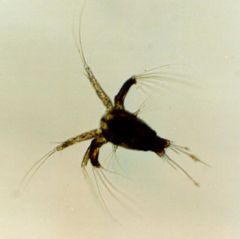
The nauplius larva of a dendrobranchiate
|
||||||||||||
The crustaceans (Crustacea) are a large group of arthropods, comprising almost 52,000 described species , and are usually treated as a subphylum . They include various familiar animals, such as crabs, lobsters, crayfish, shrimp and barnacles. The majority of them are aquatic, living in either marine or fresh water environments, but a few groups have adapted to life on land, such as terrestrial crabs, terrestrial hermit crabs and woodlice. Crustaceans are among the most successful animals, and are as abundant in the oceans as much as insects are on land. Over half of animals in the world are marine copepod crustaceans. The majority of crustaceans are also motile, moving about independently, although a few taxonomic units are parasitic and live attached to their hosts (including sea lice, fish lice, whale lice, tongue worms, and Cymothoa exigua, all of which may be referred to as "crustacean lice"), and adult barnacles live a sessile life — they are attached headfirst to the substrate and cannot move independently. Although most crustaceans are small, their morphology varies greatly and they include such large animals as lobsters 70 cm long and spider crabs with a leg span of nearly 4 m.
The scientific study of crustaceans is known as carcinology. Other names for carcinology are malacostracology, crustaceology and crustalogy, and a scientist who works in carcinology is a carcinologist, crustaceologist or crustalogist.
Structure of crustaceans
Crustaceans have three distinct body parts: head, thorax, and abdomen (or pleon), although the head and thorax may fuse to form a cephalothorax, an excellent example of tagmatization. The head bears two pairs of antennae, three pairs of mouthparts, and usually eyes (two compound eyes, an unpaired eye, or both). The thorax and pleon bear a number of lateral appendages, including the gills, and the tail ends with a telson. Crustacean appendages are used for swimming, crawling, and feeding. They may be highly modified as jaws and other structures, or may be lost. Smaller crustaceans respire through their body surface by diffusion , and larger crustaceans respire with gills or, as shown by Birgus latro, with abdominal lungs . Both systems (diffusion and gills) were being used by various crustaceans as early as the Middle Cambrian .
As arthropods, crustaceans have a stiff exoskeleton, which must be shed to allow the animal to grow ( ecdysis or molting). Various parts of the exoskeleton may be fused together; this is particularly noticeable in the carapace, the thick dorsal shield seen on many crustaceans that often forms a protective chamber for the gills. Crustacean appendages are typically biramous, meaning they are divided into two parts; this includes the second pair of antennae, but not the first, which is uniramous. There is some doubt whether this is a derived state, as had been traditionally assumed, or whether it may be a primitive state, with the branching of the limbs being lost in all extant arthropod groups except the crustaceans. One piece of evidence supporting the latter view is the biramous nature of trilobite limbs .
The main body cavity is an expanded circulatory system, through which blood is pumped by a heart located near the dorsum. The alimentary canal consists of a straight tube that often has a gizzard-like gastric mill for grinding food and a pair of digestive glands that absorb food. Structures that function as kidneys are located near the antennae. A brain exists in the form of ganglia close to the antennae, and a collection of major ganglia is found below the gut.
Despite their diversity of form, crustaceans are united by the special larval form known as the nauplius.
Although a few are hermaphroditic, most crustaceans have separate sexes, which are distinguished by appendages on the abdomen called swimmerets or, more technically, pleopods. The first (and sometimes the second) pair of pleopods are specialised in the male for sperm transfer. Many terrestrial crustaceans (such as the Christmas Island red crab) mate seasonally and return to the sea to release the eggs. Others, such as woodlice lay their eggs on land, albeit in damp conditions. In many decapods, the females retain the eggs until they hatch into free-swimming larvae.
Life Cycle
Larva Stage
The larval stage of a crustacean's life cycle is called a zoea (pl. zoeal)s. It follows the nauplius stage and precedes the post-larva. Zoea larvae swim with their thoracic appendages, as opposed to nauplii, which use cephalic appendages, and megalopa, which use abdominal appendages for swimming. It often has spikes on its carapace, which may assist these small organisms in maintaining directional swimming. In many decapods, due to their accelerated development, the zoea is the first larval stage. In some cases, the zoea stage is followed by the mysis stage, and in others, by the megalopa stage, depending on the crustacean group involved.
Taxonomy
Although the classification of crustaceans has been quite variable, the system used by Martin and Davis is the most authoritative, and largely supersedes earlier works.
Six classes of crustaceans are generally recognised:
- Branchiopoda — including brine shrimp (Artemia) and Triops (Notostraca)
- Remipedia — a small class restricted to deep caves connected to salt water, called anchialine caves
- Cephalocarida — horseshoe shrimp
- Maxillopoda — various groups, including barnacles and copepods. It contains Mystacocarida and Branchiura, which are sometimes treated as their own classes.
- Ostracoda — small animals with bivalve shells
- Malacostraca — the largest class, with the largest and most familiar animals, such as crabs, lobsters, shrimp, krill and woodlice.
The exact relationships of the Crustacea to other taxa are not yet entirely clear. Under the Pancrustacea hypothesis , Crustacea and Hexapoda (insects and allies) are sister groups. Studies using DNA sequences tend to show a paraphyletic Crustacea, with the insects (but not necessarily other hexapods) nested within that clade.
Fossil record
Those crustaceans that have soft exoskeletons reinforced with calcium carbonate, such as crabs and lobsters, tend to preserve well as fossils, but many crustaceans have only thin exoskeletons. Most of the fossils known are from coral reef or shallow sea floor environments, but many crustaceans live in open seas, on deep sea floors or in burrows. Crustaceans tend, therefore, to be more rare in the fossil record than trilobites. Some crustaceans are reasonably common in Cretaceous and Caenozoic rocks, but barnacles have a particularly poor fossil record, with very few specimens from before the Mesozoic era.
The Late Jurassic lithographic limestones of Solnhofen, Bavaria, which are famous as the home of Archaeopteryx, are relatively rich in decapod crustaceans, such as Eryon (an eryonoid), Aeger (a prawn) or Pseudastacus (a lobster). The "lobster bed" of the Greensand formation from the Cretaceous period, which occurs at Atherfield on the Isle of Wight, contains many well preserved examples of the small glypheoid lobster Mecochirus magna. Crabs have been found at a number of sites, such as the Cretaceous Gault clay and the Eocene London clay.
Consumption
Many crustaceans are consumed by humans, and nearly 10,000,000 tons were produced in 2005 . The vast majority of this output is of decapod crustaceans: crabs, lobsters, shrimp and prawns. Over 70% by weight of all crustaceans caught for consumption are shrimp and prawns, and over 80% is produced in Asia, with China alone producing nearly half the world's total. Non-decapod crustaceans are not widely consumed, with only 130,000 tons of krill being caught, despite krill having one of the greatest biomasses on the planet.
